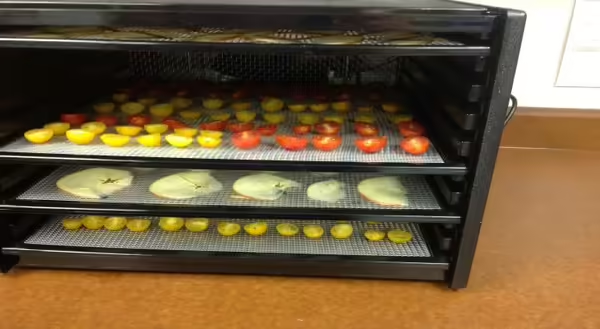
Our statewide nutrition and wellness team is hosting the "Fill Your Pantry" webinar series from June 3 to July 22. The "Drying at Home" webinar will be on June 24. Register at go.illinois.edu/preserveathome.
What is the first dried food you remember eating? I think mine was either a fruit leather or raisins. Since then, beet chips are a go-to crunchy snack for me. And I tried jerky for the first time while preserving deer jerky at work. (Yes, I didn't grow up snacking on dried meat sticks.)
As a nutrition and wellness Extension educator, one of our roles is sharing research-based information on food preservation - canning, freezing, and dehydration.
I enjoy dehydration for a few reasons:
- drying uses few pieces of equipment,
- preparation time is minimal, and
- it is a great way to "dip your toe in the water" and gain confidence in preserving at home.
What Can I Dry?
Drying - or dehydration - can be done for many foods: fruits, vegetables, herbs, meats, popcorn, legumes, and seeds.
How Does Drying Work?
Have you ever seen fresh grapes grow mold (a type of microorganism)? It is fairly common the longer grapes are stored. In comparison, raisins (dried grapes) rarely have mold appear. The difference is the drying or dehydration process. Drying preserves food by removing water to a level where microorganisms have a hard time growing.
On a side note, because water is removed, the final product is much lighter in weight and smaller in size than before it was dried, making dried foods are very portable and great for travel.
How Does Drying Change a Food's Nutrition?
Dried fruits are higher in calories than their fresh versions. Because the water content is removed during the drying process, dried fruit is more concentrated in natural sugars, called carbohydrates. A 1/4 cup of raisins contains around 30g carbohydrates and 100 calories. To get the same amount of carbohydrates and calories, you could eat around 1 cup of fresh grapes.
Where Can I Find Recipes?
The National Center for Home Food Preservation for more about dehydration equipment, tips for success, and recipes. Going into summer, I recommend drying tomatoes, herbs, and hot peppers.
Source: USDA, FoodData Central, https://fdc.nal.usda.gov/index.html
Healthy Eats and Repeat
How much difference is there between canned and frozen foods? How should you cook venison? When is the best time to buy avocados? Get answers to these questions as well as other tips, tutorials and recipes for common kitchen foods and items with University of Illinois Extension Nutrition & Wellness Educator Caitlin Mellendorf. Build your best life. Trust Extension to help.
Caitlin Mellendorf is an Illinois Extension Nutrition and Wellness Educator serving DeWitt, Macon and Piatt Counties in Central Illinois. She is a Registered Dietitian and her work focuses on helping community members gain the knowledge, skills and tools to live healthier, more nutritious lifestyles. This includes providing programs and answering questions about heart health, diabetes, food safety, food preservation, grocery shopping and cooking. You can reach Caitlin by email at chuth2@illinois.edu or call 217.877.6042.